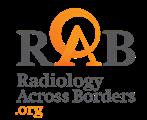










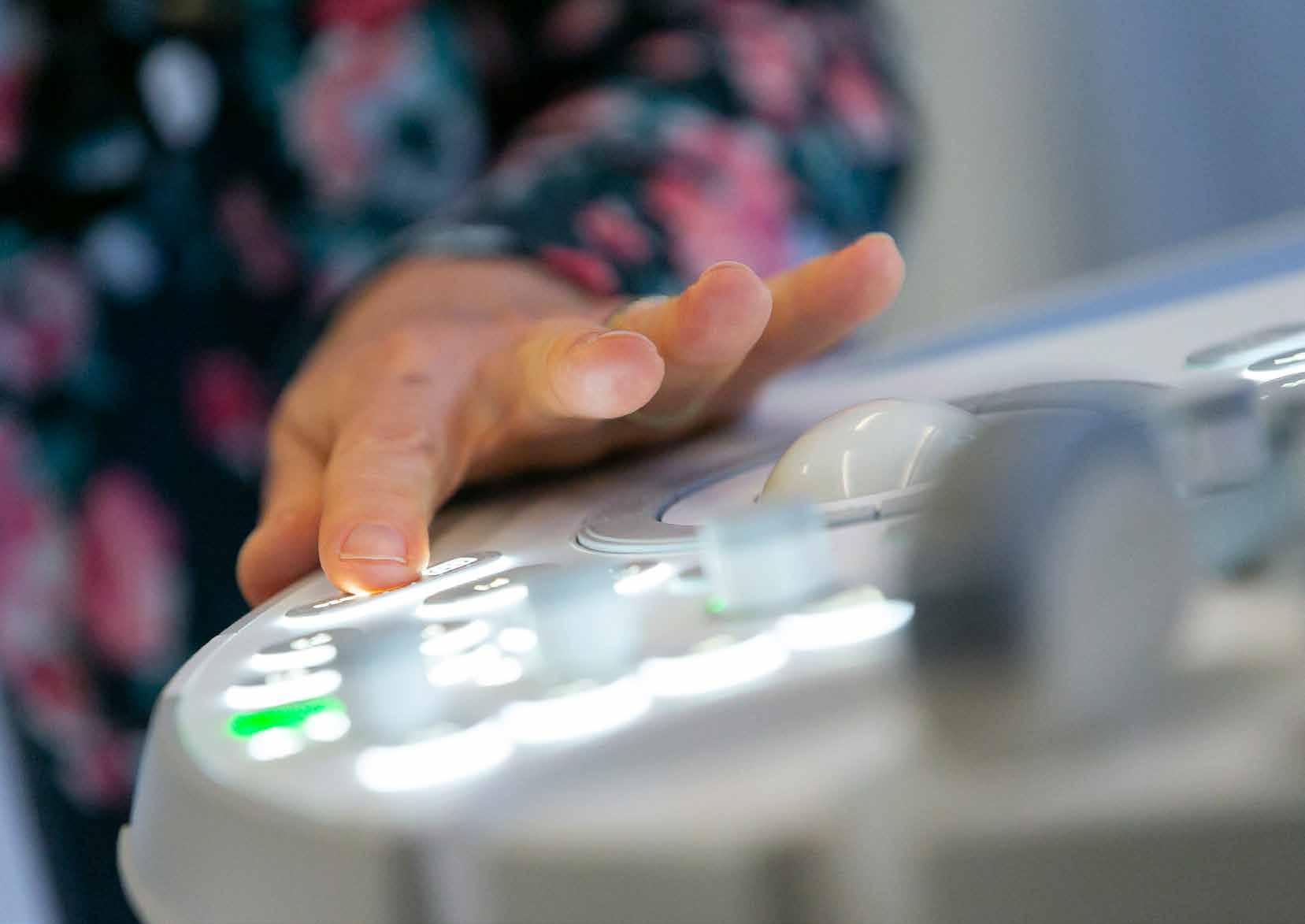





The ASA is nearing the milestone of 7,000 members. This extraordinary growth demonstrates the overwhelming willingness by sonographers to be part of the Association and they identify the value membership offers.
Considering in 2009 the membership reached 2,500, our profession, along with the ASA, has shown exceptional growth. Thank you, all members new and existing, for your support.
describing the direct impact of sonography on patient care resonated with great impact. Central themes of heart disease, cancer and obstetrics engaged large groups of the community and am sure all sonographers lifted in pride for the recognition of the work we do. Look out for the activities later this year.
Less visible to members has been the significant work and advocacy for the sonographer profession at all levels of government in Australia.
Many essential steps have been achieved in the past 12 months such as the motion passed in the Australian Senate supporting the regulation of Australian sonographers, the 2020–21 pre-budget submission highlighting workforce shortages and numerous meetings with state and federal health department officials and ministers.
Firstly, let me say how tumultuous the last 12 months have been for all sonographers, healthcare workers, along with the entire community. Through late 2019 and early 2020 bushfires ravaged significant parts of Australia, and then for many months, the COVID-19 pandemic has led to state of emergency lockdowns across Australia and New Zealand. Through all this, the ASA has achieved so much and continues to support sonographers in many ways, along with our key strategic objectives.
In my first year as President, I thank my fellow Directors for their support and dedication to the Association, especially Vice President Dr Jennifer Alphonse. The Board composition remained unchanged this year, although we welcomed Tanya Tran, who replaced Carolyn Todhunter, who after many years of service moved to a new role outside the ASA. Tanya joined the ASA in January 2020, in the combined role of General Manager Finance and Operations and Company Secretary. She has brought a wealth of experience and knowledge, which has been invaluable through the significant business changes during 2020.
During 2020 we were forced to make significant changes to our education calendar, which impacted income, yet the ASA remains financially sound. The Association’s ongoing positive financial situation mitigated the impact of COVID-19. Prudent financial decision-making by the Board and our CEO Jodie Long remains extremely important during these times.
Thank you also to the amazing office team under the leadership of Jodie. The ASA team have continued to provide a comprehensive CPD program, member support, as well as up-to-date COVID-19 resources to ensure the health and wellbeing of all members. At a time when so much varied information was available, the ASA website became a terrific reference point to find the key practical material to keep sonographers safe. Whether information on personal protective equipment, mental health and wellbeing or links to government statements, the office team did an exemplary and proactive role in compiling and promoting important information within one source. I sincerely hope all members have looked after themselves and sought help when needed.
Everyone will have recognised the Association website was completely transformed and renewed from the ground up this year. All aspects of the website were rewritten to provide members with a streamlined, easy to use interface for information and learning. The office team ensured an outstanding tender process and the rebuild has provided members and the Association with a platform for years to come. We have received overwhelming positive feedback on the changes, especially the integration of education options. And yet there are additional tools and changes to be added.
Key to the ASA strategic plan is the ongoing awareness of the role sonographers perform in healthcare and advancing the sonographer profession. In conjunction with the 2019 Australasian Sonographers Day held on 27 October, the ASA launched the Sonographer Awareness Campaign with a range of activities including a highly effective social media drive. The short, sharp videos
Progress continues on these topics even during the current pandemic and it is leading towards a significant opportunity for change in the next financial year.
Investing in sonographer research is also a longstanding key strategy for the ASA. This is demonstrated in a number of our key outcomes, such as the ongoing investment in our journal Sonography, and the ASA Grants Program. The very worthy 2020 research grant recipients are undertaking significant investigations into the sonographer workforce and profession. Congratulations to both research teams:
• Kristie Sweeney, Prof. Karen Ginn, Assoc. Prof. Martin Mackey, Dr Jillian Clarke, Dr Jacqueline Spurway –Online ergonomics training, with and without individual feedback on adherence, effective in reducing musculoskeletal upper limb pain and work performance in sonographers
• Jacqui Williamson, Dr Toakase Fakakovikaetau and Dr Boglarka Remenyi – Cardiac sonographer and cardiologist levels of agreement in echo screening for rheumatic heart disease.
Volunteering underpins our Association, with so much work performed by so many volunteers. Whether through educational activities, on Branch committees or work as a Board Director, I am very thankful to all our volunteers. To further bolster the volunteering opportunities for members, earlier this year the ASA signed a major partnership with Radiology Across Borders (RAB). Over the past several years ASA had directly sponsored the VITAL teaching program with RAB; however, this new agreement offers ASA members far more opportunities to provide unique ultrasound teaching in developing countries under the support and experience of RAB. It has been really heartening to hear of so many sonographers who have voiced support to be involved in the work of RAB as an extension of sonography in Australia and New Zealand. I am looking forward to hearing of the great work of all involved.
Due to COVID-19, great changes have occurred during the ASA education calendar in 2020. In October 2020 we hold our very first Virtual Conference with a range of expert local and international speakers. However, new education options were being planned and developed prior to the impact of the pandemic. The annual SIG symposium in 2021 is changing as it becomes restructured and offered across multiple locations in a mini meeting concept. This achieves a lower cost conference to members, with increased availability.
The recent year has been unprecedented in so many ways and impacted lives and businesses so greatly. The ASA continues in a strong financial position, supporting members and achieving our strategic goals. Thank you again for the hard work by Jodie Long, the office staff and the Board throughout this period. Thanks to our members, especially those who are working within COVID-19 hospitals and departments providing sonography in the most difficult circumstances. It is exceptional work that is so important to patient care.
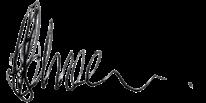
Ian Schroen President, Australasian Sonographers Association

reach over 1.5 million people with our message that Sonographers are your Ultrasound Experts.
This year has seen the organisation continue to provide members with the highest quality professional development and deliver diverse and new CPD opportunities with the introduction of in-depth education videos, recordings of international speakers at our International Conference and the launch of our Learning Management System. In addition, the ASA formed a partnership with Philips Healthcare which enabled us to deliver dedicated cardiac days to our cardiac sonographers as well as other cardiac specific CPD opportunities.
COVID-19 unfortunately caused the cancellation of a number of our face-to-face events; however, up until March we saw increased attendance at all our branch activities, as well as our travelling workshops. To ensure we continued to support our members’ professional
The last 12 months have seen significant changes for the profession, the ASA and the world we live in.
In the last four months of the financial year, the ASA had to adapt to a new way of delivering continuing professional development as we faced the inability to host face-toface events, including cancelling our Annual International Conference.
In addition, the ASA was a source of support for our members during a very difficult time. Some members became unemployed, with many having to accept reduced hours of work. This swift and drastic change is something we did not ever envisage affecting sonography, considering the vital services the profession provides.
Even with the setbacks, we still have so much to be proud of over the last 12 months, especially in raising the public’s awareness and increasing sonographers’ professional recognition so that sonographers are known as experts in ultrasound across the community.
In October, in conjunction with Australasian Sonographers Day, the ASA launched a four-week, large-scale social media awareness campaign with the help of a creative agency. Ten adverts that highlighted the important role of sonographers were posted on targeted public Facebook, YouTube and Instagram feeds, which enabled us to
development, we quickly moved to adding many more online learning opportunities that saw us deliver eleven webinars in three months.
The ASA International Conference is the pinnacle event in our calendar every year and this year for the first time saw us cancel this event; however, this brings new opportunities and for the first time the ASA will be hosting an interactive virtual conference.
The ASA has continued this year advocating for sonographers to be regulated in Australia to ensure the protection of the public’s health and safety. We also proposed ways the Australian and New Zealand governments can assist with increasing the number of sonographers, ensuring the public have access to vital ultrasounds.
Over the last 12 months we have been the voice of sonographers at 20 meetings with politicians, as well as attending 45 meetings within the medical industry.
The highlight of the year was when the Australian Senate agreed to a motion that called on the Federal Government to sponsor a submission from the Australasian Sonographers Association to the COAG Health Council for consideration of the proposal for sonographers to be regulated.
Throughout the year the ASA scoped a professional and modern new website that is a reflection of the sonography profession. The new website was developed with the end user in mind, giving members the ability to access more information as well as move easily between the website and our new learning management system.
This ‘one stop shop’ also allows our members to have a personally customisable dashboard showing all their ASA activity.
Phase 1 of the site was launched in June and next year will see us continue to add additional features, such as a dedicated app, as well as the development of a consumer website that will help promote the role of sonographers.
Keeping sonographers up to date with the latest information is a key focus of the ASA and this became critical with the changes brought about by COVID-19. Our members looked to us for support and guidance during this very difficult time. To assist, we developed dedicated website pages with timely information regarding PPE and safe practice, workforce redeployment, Australian and New Zealand government information and mental health and resilience resources.
Evidence-based practice and research is so important for the standing of our profession within the healthcare community. Our scientific journal Sonography has continued to grow in readership across the world, with downloaded articles increasing by 77% compared to other Wiley journals in the radiology imaging group, which grew 40% on average. The ASA could not continue to deliver value to members year on year without the support of our corporate partners and those members who graciously volunteer their time
on committees or who impart their knowledge through presentations in various forms. This year, your continued support during very difficult times has been significant, and would personally like to thank all of you.
There is also a team of dedicated ASA employees who go above and beyond for the members every day and who always put the members first.
The resilience this team has shown to be able to continue to be there for our members and deliver them a new website and learning management system all whilst working from home is a testament to their dedication to always ensuring our members are supported. To all the ASA staff, I say thank you for your contribution, the ASA could not have achieved everything it has over the last 12 months without you.
The next 12 months will certainly be very different; however, the ASA with the commitment of its members, corporate partners and staff will be able to navigate the new landscape and keep delivering value and be the support for close to 7000 members. The ASA will continue to lead the sonography profession and be its voice, advocating for sonographer regulation within Australia, improving the workforce situation across Australasia and raising awareness of the vital and important role sonographers have in delivering ultrasound services to the public.

Jodie Long CEO, Australasian Sonographers
Association
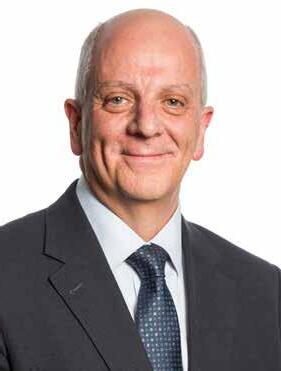
Whilst the overall revenue was down compared to 2019 financial year due to the lack of registration and corporate partner income relating to the 2020 annual conference, the ASA experienced strong membership growth in the 2020 financial year, which enabled the Association to deliver valued services to members.
A $60,679 reduction in the value of investments was inevitably recognised in the 2020 financial year due to the effects of COVID-19 on the global financial markets. Whilst disappointing, the ASA’s investment policy ensures such losses are minimised through ongoing monitoring of the investment portfolio as well as a conservative and ethical approach to investments.
The ASA was able to deliver a surplus of $328,583 in the 2020 financial year, which is an exceptional result given the challenges posed by COVID-19 since March 2020.
This surplus delivers four consecutive years of positive returns, which provide a strong foundation for the ASA and strengthens the long-term viability of the Association.
I would like to acknowledge the contribution of our members and corporate partners and the efforts of the ASA staff and fellow Directors in achieving this result during the most challenging period experienced by our Association and other organisations around the globe.
The most significant disruption to the organisation throughout the year was the cancellation of the annual conference ASA2020 Melbourne scheduled in May, due to COVID-19 restrictions relating to events. However, with the support of our corporate partners and members who have chosen to roll over their registrations to the ASA2021 Brisbane conference, and through effective management of organisational costs, the ASA was able to ensure a minimal financial impact on the Association.
The ASA has managed its expenditure effectively throughout the year with continuous efforts to minimise overheads whilst providing ongoing value to members.
The most significant variance to expenditure in the 2020 financial year compared to previous financial years was the lack of conference expenses recognised in 2020 due to the cancellation of the annual conference. Consequently, the total expenditure for the 2020 financial year was 15% less than in the previous year. Corporate services expenditure contributed to 48% of total expenditure in the 2020 financial year compared to approximately 35% in the prior financial year. This was primarily due to the overall reduction in total expenses, but also includes the hiring of an additional staff member to fulfil the role of CPD Content Advisor.
In line with our strategic objectives, the ASA’s expenditure budget places an emphasis on the organisation’s advocacy, marketing and the recognition and regulation of the profession.
Australasian Sonographers Association Ltd Directors' declaration
30 June 2019
In the directors' opinion:
The attached financial statements and notes comply with the Australian Charities and Not-for-Profits Commission Act 2012 including:
In the 2020 financial year, the Association allocated funds to the Sonographer Awareness Campaign where we utilised a creative agency to develop ten advertisements for Facebook and YouTube in order to promote the expertise of sonographers to the general public.
our members continued benefits in the form of a new and sophisticated website and a state of the art, integrated learning management system.
● Giving a true and fair view of the company's financial position as at 30 June 2019 and of its performance for the financial year ended on that date;
● Complying with Australian Accounting Standards – Reduced Disclosure Requirements and the Australian Charities and Not-for-Profits Commission Regulation 2013; and
● There are reasonable grounds to believe that the company will be able to pay its debts as and when they become due and payable.
Signed in accordance with a resolution of the directors:
The net assets at ASA has grown to $2.47 million as at 30 June 2020.
On behalf of the directors
The reduction in investments in the 2020 financial year is offset by the increase in available cash due to the conservative approach of ensuring liquidity to pay bills should a significant drop in revenue eventuate due to COVID-19. Fortunately, at the time of writing this report, no such drop in revenue has been recognised post 30 June 2020 and funds continue to be reinvested in term deposits where possible.
The ASA’s financial management over the last few years has resulted in the organisation now being in a strong financial situation, which places the Association in the position of being able to continue to deliver exceptional value to our members and the sonography profession despite the challenges of unforeseen circumstances such as COVID-19.

Jennifer Alphonse Silvano Palladino Director Director
A proportion of previous years’ surpluses were invested by the Association in the 2020 financial year to deliver
10 September 2019
Melbourne
10 September 2019
Silvano Palladino Director and Finance and Risk Committee Chair, Australasian Sonographers Association
Melbourne

For some time, sonographers have lamented the lack of recognition as being the experts in ultrasound. 2019–20; however, saw a major shift in engagement with the successful introduction of the Sonographer Awareness Campaign. Organic growth of the ASA’s social media presence has seen the Association rise to a position of prominence as the voice for sonography.
#proudtobeasonographer
#supportingsonographers

On Australasian Sonographers Day, 27 October, the ASA launched the Sonographer Awareness Campaign
The campaign was born from the statistic that just 11 per cent of the public knew that it is a sonographer that performs the majority of ultrasound scans.
The four-week campaign used social media advertising on Facebook, Instagram and YouTube with the aim to empower the audience with this simple knowledge and recognition of the profession.
The campaign reached 1.5 million people and the cost was the equivalent to only four per cent of membership revenue.
For over a decade, sonographers have felt professionally invisible and have indicated considerable dissatisfaction with the lack of recognition. The Sonographer Awareness Campaign was the first significant step to rectifying this problem.
Social media advertising was chosen to target specific audiences in a cost-effective manner, ensuring our awareness message repeatedly reached the right people. ASA brand ambassadors were also appointed to actively increase our audience reach and our Corporate Members also shared the advertising on their channels.
By the numbers:
people reached in 4 weeks
of membership fees went to the campaign, equalling great value



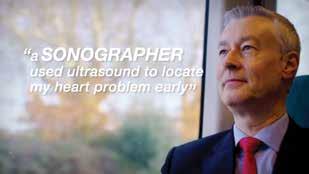
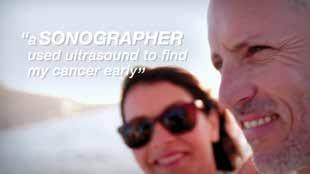
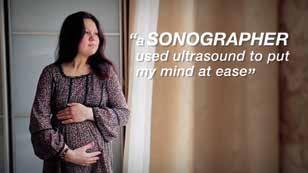


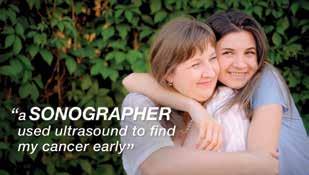

The ASA invested considerable time to cultivate its social media presence through 2019–20. Focusing on all mainstream platforms, the regular, relevant and diverse posts resulted in strong organic growth.
The introduction of a content management system has provided the Association with excellent data on the performance of our posts. Of particular note are Twitter and Instagram followers up 66.7% and an incredible
By the numbers:
Engagement by platform 2019–2020
160% respectively. Both Facebook and LinkedIn forged ahead with 18.5% and 29.6% growth. In raw follower numbers, the ASA is the leading commentator on sonography by some margin.
Over the next 12 months the Association will continue to invest in social media, and will examine further opportunities where we can act as a thought leader in the community.
Top 3 social posts for 2019–2020
up 160% up 66.7%
6,110 reached
869 engagements

29.6%



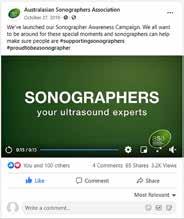
18.5%
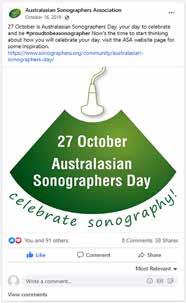
14,651 reached
1,220 engagements
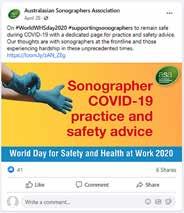
4,775 reached
571 engagements

The ASA achieved an important next step towards sonographer regulation in late 2019 when the Australian Senate passed a motion supporting the proposal to regulate Australian sonographers. The motion passed with unilateral support, but there is some way to go before regulation is a reality. We must thank former Greens Leader, Senator Richard Di Natale, who tabled
the motion to the Senate, and Health Minister Hon Greg Hunt MP who supported its passage.
The next step is to have a submission to the Council of Australian Governments (COAG) Health Ministers meeting, calling for regulation of sonographers in Australia.
In all, the ASA produced 18 submissions to government through the period, with the single most important being the 2020–21 pre-budget submission to the Australian Government. Amongst other things, this document detailed the two strategic initiatives of sonographer
regulation and workforce shortage. The document identified and costed appropriate solutions, such as investments into clinical training models for foundational student training.
The ASA increased engagement with the NZ Government, the Ministry of Health, unions, regulators, industry bodies and employers on the key issues of workforce shortage and sonographer training. In particular, the ASA facilitated
meetings of Australian and New Zealand educators to explore options that aim to increase the training numbers of sonographers in New Zealand.
Delivering macro level change, such as regulation of the profession in Australia, or addressing workforce shortages, can only be achieved by advocating to government. In these discussions the ASA acts as the unified voice for sonographers and the industry that supports it.
Equally in times of crisis, relationships with government, regulators and peak bodies serve to gain access to vital information while also working to secure the safety and wellbeing of members. submissions
industry committee meetings representing sonographers responses to gov’t consultations political meetings new guidelines available for members position statements
Throughout the year the ASA continued to provide the largest selection of sonographer CPD opportunities in Australasia. From online activities, such as webinars, CPD tests and educational videos to a variety of face-to-face meetings, across Australia and New Zealand, the ASA provided members the highest quality professional development.

The Association hosted 43 Branch Meetings with 1,856 attendees, and 6 Branch Workshops with 433 attendees. There were fewer workshops and meetings due to COVID restrictions, but each of the meetings recorded increased participation.
Adding to locally based learning activities, the Association saw the introduction of two new Branches, Mid-North Coast NSW and South-West WA, bringing the total to 25 ASA Branches across Australia and New Zealand.
Travelling Workshops numbered 17; 10 were postponed due to COVID, with 676 attendees. Like the Branch Meetings and Workshops, the Travelling Workshops proved very popular with members and all saw increases in attendances.
Cardiac Days in Sydney and Adelaide and a Cardiac Student Day in Brisbane attracted 116 members in total, which is an exceptional response for a new initiative. The ASA undertook these days in partnership with Philips.
Branch Meetings and Workshops with attendees
Of our major face-to-face meetings, the ASA Symposium in Canberra offered 11 CPD points over two days in October 2019. The excellent program, networking opportunities and trade exhibition attracted 288 attendees.
ASA2020 Melbourne, which was initially scheduled for late May 2020 was postponed because of COVID. The Association quickly pivoted and negotiated to have our conference run alongside the RANZCR conference later in the year. Unfortunately, both had to be cancelled due to the ongoing pandemic.
Determined to offer a conference in the 2020 calendar year, the Association moved to an online format.
ASA2020 VIRTUAL will be held on 17–18 October 2020, with 13 CPD points available. To offer a dedicated cardiac stream over the same period, the Association has partnered with Echo Australia to deliver their virtual conference on 15–16 October 2020.
days of SIGS2019 Canberra symposium with attendees
Travelling Workshops with
attendees, a large é per event
Cardiac Days with attendees
new branches
In 2019–2020 the ASA recorded 21 webinars. With a dedicated CPD Content Advisor appointed, output of quality online learning more than doubled for the period, which was particularly important as the last quarter of the year saw no opportunities for face-to-face learning because of COVID.
CPD testst based on the Editor’s choice of an article selected from each issue of Sonography, provides four online CPD opportunities per year, but this was extended by a further five when the Association did a special Top Authors articles for 2019.
For members who could not attend a physical conference, we provided six presentations as part of a conference recordings package members could purchase. Members could purchase individual presentations or all six. These proved very popular with 384 CPD points being awarded to members through this system.
In a new innovation, the Association introduced educational videos that take webinars to the next level. These in-depth videos run between 60–90 minutes and have proven a success, with positive member feedback
By the numbers:
across the board. These videos offer the content of face-to-face learning from the comfort of home, covering various aspects of the examination via live scanning, machine setup and patient positioning and then covering the foundation knowledge of the anatomy, normal and pathological findings. Two were launched over the period, and three more planned; however, these were delayed due to COVID.
Importantly, bringing all of this together later in the year was the launch of ASA Online – the largest online sonographer CPD resource in Australasia. As part of the new ASA website, ASA Online is a simple-to-navigate resource housing all of the Association’s online CPD opportunities.
ASA Online provides members the capacity to access content anytime, anywhere, with no time limits. With a fully integrated backend, ASA Online activities are linked to CPD certificates, which accumulate on the member dashboard. Maintaining this information in a single, easyto-access platform provides members with value and peace of mind.
new webinars conference recordings with CPD pts awarded new educational videos & more coming ASA Online, learning anytime, anywhere launched
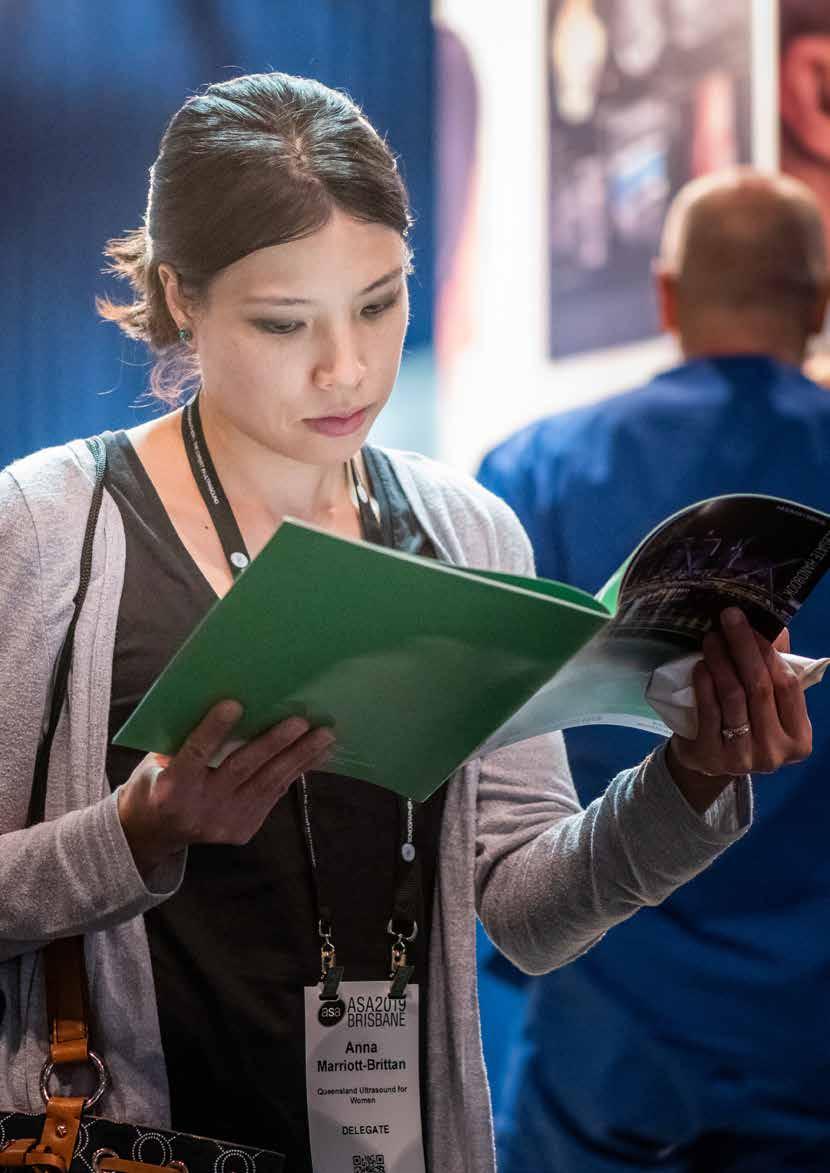
Evidence-based research is crucial to the advancement of the profession and improved patient care. From publishing the ASA journal Sonography, through to directly funding clinical research and undertaking studies on the state of the profession, the ASA is deeply committed to advancing the profession.
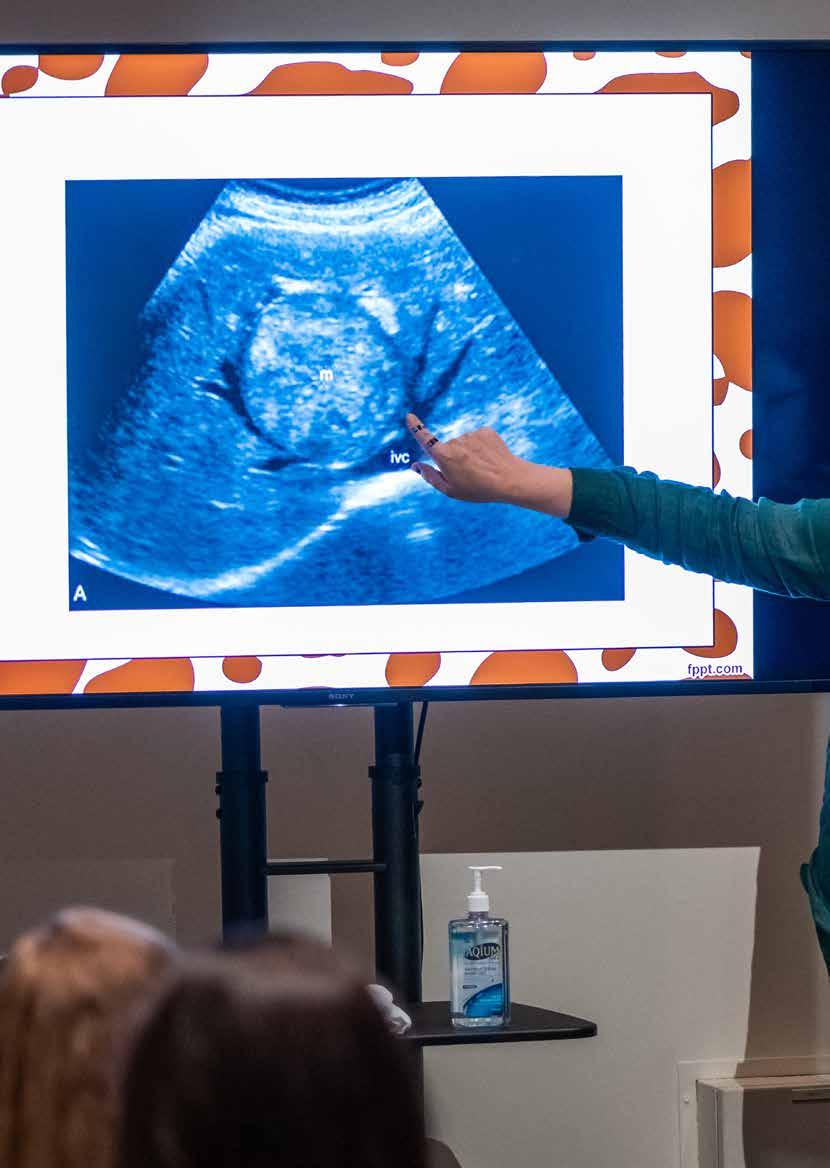
Through the Research Grant Scheme, the ASA funded A$30,000 of new research that contributes to sonography practice. Specifically, this funding supports members to undertake quality research, which will then lead to publications and contribute to the evidence base of sonography.
This year, funding went to:
Kristie Sweeney, Prof. Karen Ginn, Assoc. Prof. Martin Mackey, Dr Jillian Clarke, Dr Jacqueline Spurway (Host organisation: Western NSW LHD Medical Imaging)
– Online ergonomics training, with and without individual feedback on adherence, effective in reducing musculoskeletal upper limb pain and work performance in sonographers
Jacqui Williamson, Dr Toakase Fakakovikaetau and Dr Boglarka Remenyi (Host organisation: Ministry of Health, Tonga)
– Cardiac sonographer and cardiologist levels of agreement in echo screening for rheumatic heart disease
This year the ASA signed with the University of South Australia Centre for Allied Health Evidence (iCAHE) to undertake a research project: Evaluation of sonographer administered ultrasound-guided musculoskeletal injections at three pilot sites in south-east Queensland
The research evaluates the benefits of sonographers administering ultrasound-guided musculoskeletal injections to patients in radiology clinics under the direction of a radiologist.
The specific aims are to assess:
the impact sonographer administered musculoskeletal injections have on patient safety
the impact sonographer administered musculoskeletal injections have on the patient.
The project is estimated to be completed in 2021 and should provide an indication of possible opportunities for extended scope of practice for sonographers.
The employment and salary survey conducted late in 2019 achieved the highest response rate from members to date. The important industry data on sonographers’ employment conditions, entitlements and remuneration are benchmarked against previous results. This information is vitally important for advocating with governments.
The ASA is financially supporting the University of South Australia in undertaking a research project ‘What is the impact of COVID-19 on the Australasian sonographic community captured at three time points during the pandemic?’
COVID significantly impacted the sonography profession and it is important for the profession that we capture this impact with regard to:
• reductions in work hours
• diversification of duties
• incidences of cessation of certain scans
• protocol changes
• and wellbeing.
The full extent of the effects may assist in the formation of future guidelines and protocols.

The ASA’s peer reviewed journal Sonography is one of the key ways the profession contributes to the clinical knowledge of the global sonography community. Article downloads increased by 77 per cent in 2019. This compares with an increase of 39.5 per cent across all Wiley journals in the radiology and imaging group.
The top downloading countries were the USA (35 per cent), Australia second (18 per cent) and the United Kingdom third (9 per cent).
As part of the global community of sonographers the ASA adds to the body of knowledge that drives better practice. The mechanism that has the greatest impact is the Sonography journal, which is widely accessed globally.
Importantly, for the first time, the journal has been made available to a large number of institutions in the developing world free of charge.
Top 3 most downloaded articles
Sonography is now available to 6,198 institutions worldwide via Wiley subscriptions. This is close to a 30 per cent increase from 2018.
A further 6,193 institutions were provided with the journal free of charge in the developing world through Wiley’s philanthropic initiatives, giving access where it is needed most.
Delivering member value and support is a key driver of the Association. Over this period the ASA made significant strides in increasing value to members through keeping them informed, providing exceptional service, maintaining strong relationships with industry and providing support to those in need.

Each year the ASA’s member services team takes thousands of phone calls and responds to just as many member emails. The member services team is the backbone of one-on-one contact between the ASA and sonographers, either answering or directing calls on a vast range of topics from CPD points, change of membership status, to where to obtain employment award information.
The team is dedicated to delivering a satisfactory outcome for members with each contact. Continuing with
By the numbers of member emails and calls answered
the excellent service standard set over previous years, and the majority of enquiries by telephone were able to be answered immediately, and emails within a few hours of being received.
Even with COVID forcing the ASA Office to close, the team responded with exceptional professionalism whilst working remotely.
Issues dealt with on the spot or within hours
dedicated member services staff

Keeping sonographers up to date with the latest information that affects their practice and professional interest is a key value proposition for the Association.
Over the period, the ASA delivered information about clinical best practice, government regulation, changes to CPD requirements, the latest in ultrasound research from around the world, and much more.
Be it through social media engagement, email, the ASA website or publications like Cross Section, Making Waves, soundeffects news, or Sonography, the ASA ensured that members were the first to know of what was of interest to sonographers across Australasia.
From March 2020 onwards, the ASA rallied to support members through the COVID pandemic with timely
By the numbers:
issues of cross section regular publications
information regarding PPE and safe practice, workforce redeployment, Australian and New Zealand government information and mental health and resilience resources.
Over a crucial six-week period the ASA established and updated a dedicated COVID-19 resource for members, delivering 112 updates through our website, social channels and other communications.
Not only was the ASA supporting members through daily and sometimes hourly updates, we were also advocating for the distribution of PPE and the continuation of community imaging services to Australian and New Zealand governments. Both independently, and with a coalition of peak imaging bodies, we were and still are at the frontline of this evolving pandemic.
Year on year the ASA continues to attract more corporate partners who work collaboratively with the ASA to advance the sonography profession. The ASA, together with its partners, delivers sonographers high quality professional development as well as providing support and encouragement to excel through ASA Employer and ASA Student Awards.
The ASA is the voice for the sonography profession, which includes being the voice for all our partners who teach, employ and also work with sonographers when advocating to governments and regulators. Our partners’
By the numbers:
insights and support are invaluable and the ASA is proud that it can advocate not only on behalf of sonographers but also for the industry that supports them
The strength of the ASA’s partnerships was paramount this year when we had to cancel ASA2020 Melbourne due to COVID-19, with the vast majority of sponsors and exhibitors committing to attend ASA2021 Brisbane.
The ASA is extremely grateful to all our partners for offering their continued support to the ASA during very difficult times.












social posts
COVID-19 updates in six weeks
Representing a seismic shift in the way the ASA delivers vital news and access to resources, the new website is a ground-up redevelopment of the Association’s information and learning offerings that reflect the professionalism of sonography.
The website acts as a ‘one stop shop’ where members are provided a personally customisable dashboard that brings CPD activity, events, membership and insurance information together in a single resource.
By the numbers:
new or heavily revised pages of content
Delivered to members at a time when access to information was crucial, the logical and intuitive website is optimised for both mobile and workplace functionality. Having successfully completed phase 1 of the site development, early 2020–21 will see further enhancements added to the site.
optomised for mobile and desktop devices
YOUR DASHBOARD launched on time and on budget
personalised member dashboard
Through the pandemic, as membership renewals came around, the ASA maintained levies to members at 2019 levels. Recognising the possible financial strain on members, the ASA introduced monthly membership payments to help spread the cost and offered hardship options to members who were adversely impacted by the COVID shutdown.
By the numbers:
$0
To further assist members, the ASA offered the deferment of insurance payments, a vital component of practice, to October 2020. Both of these options, as well as the provision of ASA service, saw strong member retention through the renewal period.
increase in membership fees months deferral of insurance payments monthly payments introduced

Directors provide the organisation with guidance and support and are the guardians of the organisation’s vision and mission.
The Board and the ASA are also supported by the Sonographer Policy and Advisory Committee, Education Advisory Committee, Special Interest Groups, Branches, Sonography Editorial Board, Conference Program Committees and the Fellowship Panel.
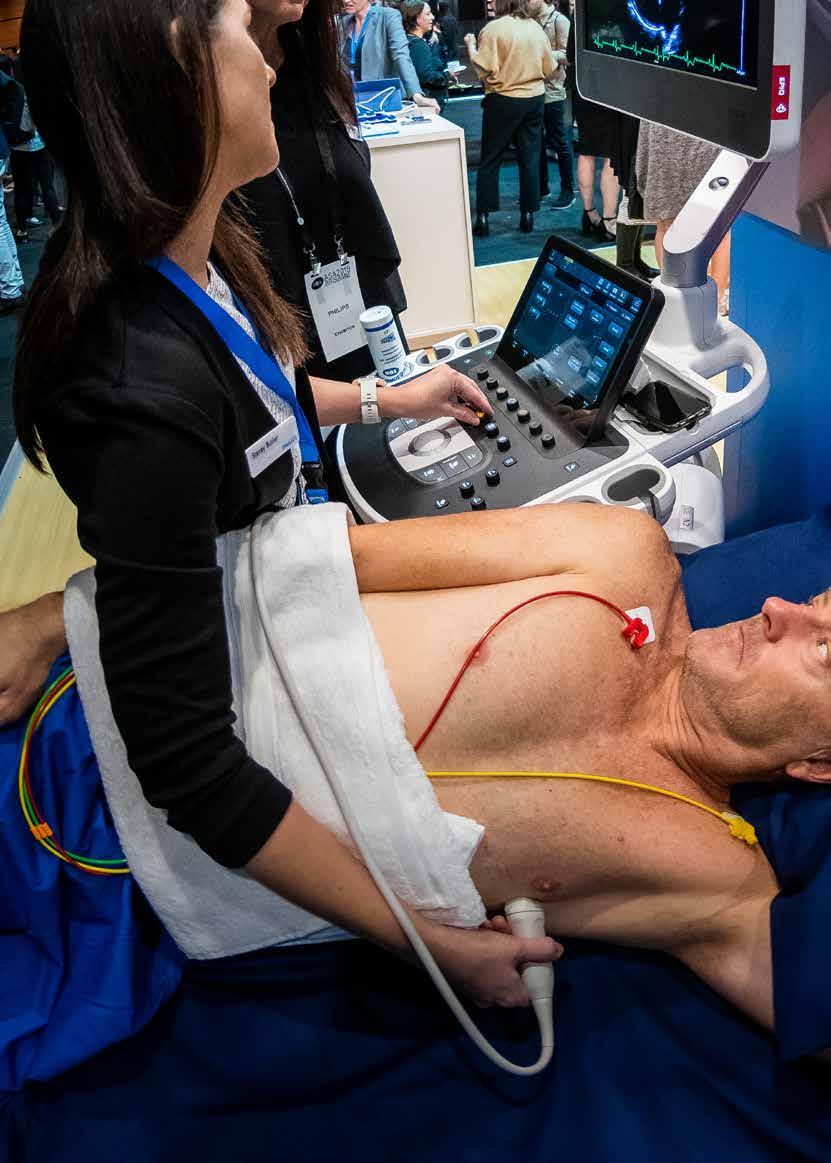
Governance Committee
Chair Ian Schroen
Finance and Risk Committee
Chair Silvano Palladino Advisory
Sonographer Policy and Advisory Committee
Chair Anthony Wald
Education Advisory Committee
Chair Frauke Lever
ASA Fellowship Panel
Chair Jessie Childs
Annual Conference Program Committee
SIG General
SIG Cardiac
SIG Musculoskeletal
SIG Paediatric
SIG Research
SIG Vascular
SIG Women’s Health
SIG Sonographer Health and Wellbeing
Alice Springs
Chair Ashtyn Lee
Auckland-Waikato
Chair Scott Allen
Australian Capital
Territory
Chair Teri Carmody
Central West NSW
Chair Jacqueline Spurway
Darling Downs
Chairs Haidee Janetzki, Kristine Lawless
Far North Queensland
Chair Sarah Robb
Gippsland
Chair Tania Waixel
Gold Coast
Chair Anna-Maria Galea
Goulburn Valley
Chair Kristy Thomas
Illawarra
Chair Lauren Dwight
Mackay
Chair Ainslie Heinke
Mid Central NZ
Melissa Westwood, Deb Mackintosh, Amanda Radic
Mid North Coast NSW
Chair Janelle Vignes
Moreton Bay
Chair Chris Edwards
Newcastle
Chair Sonya Simpson
New South Wales
Secretary Sarah Skillen
North Queensland
Northern Territory
Chair Chloe Lipp
Queensland
Chair Chris Gilmore
Riverina
Chair Simone Francis
South Australia
Chair Sandhya Maranna
South West Western Australia
Chair Natalie Clements
Sunshine Coast
Chair Kylie Elmore
Tasmania
Emma Brodribb, Kathryn O’Driscoll, Zara Ramm
Victoria
Chair Lynne Johnson
Wellington
Chair Paula Carryer
Western Australia
Chair Gail Crawford
The Directors present their report, together with the financial statements, on the company for the year ended 30 June 2020.
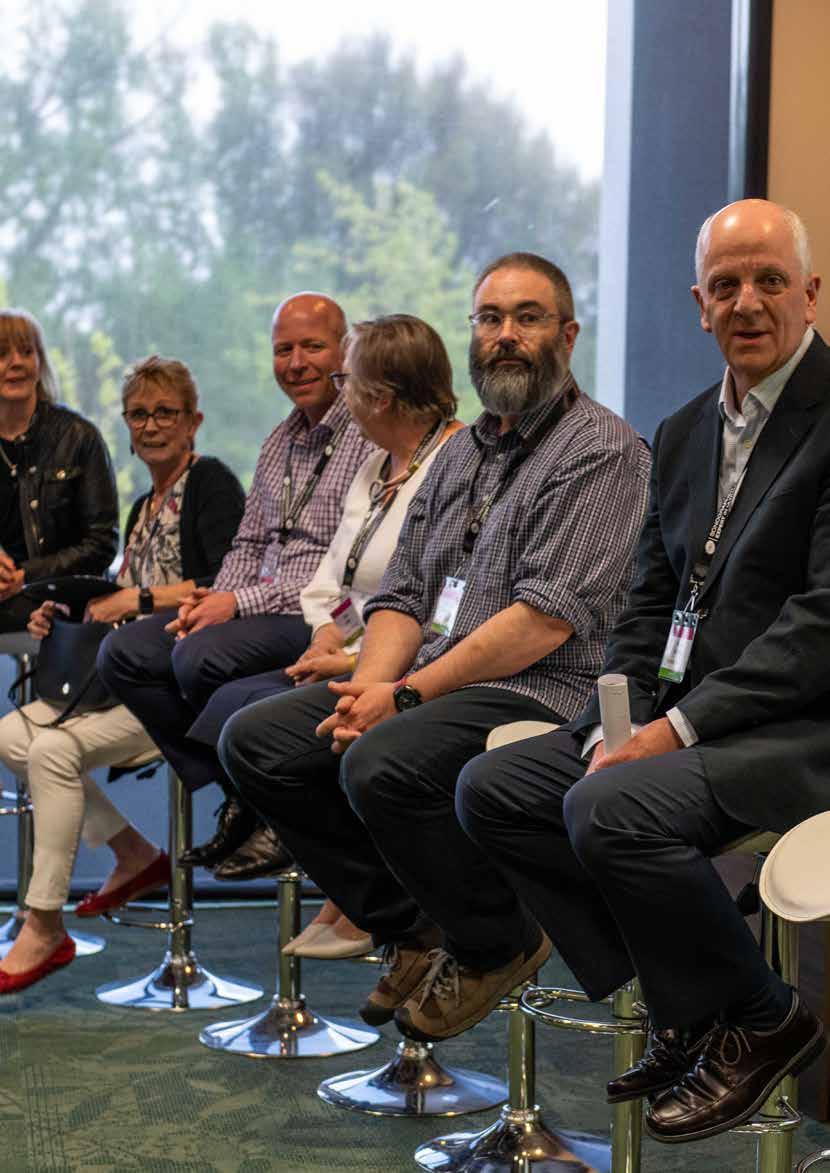
The following persons were directors of the company during the financial year and up to the date of this report, unless otherwise stated.

BAppSc (Medical Radiations), Dip Medical Ultrasound (Vasc), M Medical Ultrasound
Ian’s career to date has been diverse and challenging, centered around ultrasound. Ian first gained a passion for vascular ultrasound during the 1990s and after a number of years in clinical ultrasound, he moved to a corporate role.
Well known for his work at Philips Healthcare, Ian returned to clinical ultrasound and completed the Masters of Medical Ultrasound.
Engaged in clinical ultrasound, research and teaching opportunities and has a passion for all aspects of ultrasound. He presents regularly in various forums across a range of clinical and non-clinical topics. Ian is currently site supervisor and senior sonographer within I-MED Victoria.
Special Responsibilities
• President and Board Chair
• Chair, Governance Committee
• Finance and Risk Committee
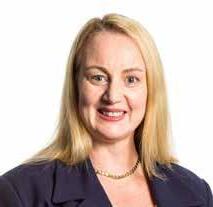
PhD, GradDipAppSc Medical Ultrasonography, BAppSc (Medical Radiation Science) Nuclear Medicine, AssocDip Nuclear Medicine Technology
Jennifer is a senior sonographer specialising in obstetric and gynaecological (O&G) ultrasound at a tertiary private O&G practice in Sydney. Having completed her PhD in 2015, Jennifer holds an Adjunct Lecturer appointment at UNSW with extensive experience in research and is co-author on 18 scientific publications. Jennifer was appointed as a Senior Lecturer with CQUniversity in August 2020 having been a casual external marker since 2017.
Jennifer has completed her Foundations of Directorship with the Australian Institute of Company Directors. Jennifer has been a member of the ASA Board of Directors since 2015 and was elected President in February 2017 before stepping down in November 2019.
Special Responsibilities
• Vice President
• Finance and Risk Committee
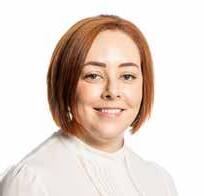
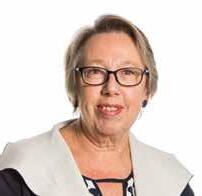
Erika
Cavanagh
M Medical Sonography, GradDipAppSc Medical Ultrasound, GradCert Health Professional Education, BAppSc Medical Radiation Technology (Medical Imaging Technology)
Erika is a staff sonographer at the Mater Centre for Maternal Fetal Medicine. Prior to this she was an Advanced Sonographer at Gold Coast University Hospital Maternal Fetal Medicine and was the Chief Sonographer at the Royal Prince Alfred Hospital in Sydney for nine years. Erika has a keen interest in sonographer education and advanced practice, and in 2016 completed a Masters of Sonography.
She is currently a PhD candidate at QUT Mater Medical Research Institute.
Erika has been a member of the ASA Board of Directors since 2014 and was the Vice President 2017/18.
Sarah Colley
Dip Medical Sonography, Cert Nuclear Medicine
Sarah is a general sonographer with extensive experience in the ultrasound industry and also in education and training. She is currently working on a casual basis teaching in emergency at RPAH.
Sarah was involved in the establishment of the postgraduate ultrasound qualification at Sydney University in 1990, where she returned in an Honorary Associate position teaching ultrasound to medical students until 2015. In addition, she has served as the Secretary of the Diploma of Medical Ultrasound Examination Board (1987–1990).
Sarah has been a member of the ASA Board of Directors since 2013 and was the ASA’s Vice President in 2014/15.
Special Responsibilities
• Finance and Risk Committee
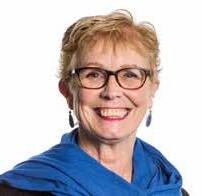
Michele
Dowling
GradDipAppSc Medical Ultrasound, BAppSc Diagnostic Radiography, Dip Radiography, Therapy
Michele is currently a senior sonographer at a Private Imaging Group in Sydney, having begun her career in London as a radiation therapy radiographer, and then as a diagnostic radiographer in Sydney, Australia.
She has extensive clinical management experience as a group practice Chief Sonographer, managing a large team of sonographers and students across nine locations.
Michele has been a member of the ASA Board of Directors since November 2016.
Special Responsibilities
• Governance Committee
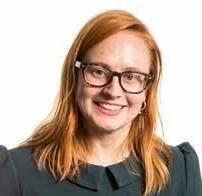


Kelly Griffiths
Australian legal practitioner, LLB Hons, BA,
GradDip Intellectual Property Laws
Kelly is currently the Head of Government Affairs and Policy at GSK, one of the world’s largest bio-pharmaceutical companies. Kelly is admitted to legal practice, with over 14 years’ legal experience, including at top tier Australian law firms (Allens & Minter Ellison), the Australian Securities and Investments Commission and as chief legal counsel for GSK. Kelly has served as a nonexecutive director on two not-for-profit boards; Youth Empowerment against HIV/Aids Ltd (including as company secretary) and Ranters Theatre Inc.
Special Responsibilities
• Governance Committee
Stephen Mackintosh
BAppSc (Medical Radiations), Dip Medical Ultrasound, PG Dip HlthSc (MRI), PG Cert HlthSc (Clinical Research) MHSc
Stephen is a general sonographer and MRI technologist working for Pacific Radiology in Palmerston North, New Zealand. He has particular interests in musculoskeletal imaging and clinical education. Stephen is the first New Zealand member to be appointed as an ASA Director and has strongly supported the ASA’s expansion into New Zealand. In addition, he has been on the convening committees for the Special Interest Group Symposiums held in Wellington (2013) and Queenstown (2016).
Stephen has been a member of the ASA Board of Directors since 2014 and was the ASA’s Vice President in 2016/17.
Special Responsibilities
• Finance and Risk Committee
BSc (Med Sc), Dip Mgt, MHlthMgt, Fellowship of the Australian Society for Microbiology, Fellowship of the Faculty of Science (Royal College of Pathologists of Australasia), GAICD
Silvano is a qualified medical scientist with experience in laboratory medicine and laboratory management. He was previously the Executive Director of PathWest Laboratory and an adjunct associate professor with the University of Western Australia’s Faculty of Medicine. Silvano has a strong interest in the professional and workforce matters affecting the health sector. He has worked with various national professional bodies such as the National Coalition of Public Pathology Providers and the Workforce Advisory Subcommittee of the Pathology Agreement Advisory Committee (PAAC) in promoting those issues to federal and state governments. He is also a Foundation Fellow of the Royal College of Pathologists of Australasia’s Faculty of Science, and was a member of the Faculty’s Foundation Committee.
Silvano was appointed to the ASA Board in 2015.
Special Responsibilities
• Finance and Risk Committee –Chair

Julie Toop
LLB, GradDip Notarial Studies
Julie is currently the Emerging Channels Lead, Retail Banking at ANZ. She has considerable expertise in the health sector, having set up ANZ’s specialised Health segment in Business Bank in 2014. Julie is a Notary Public and lawyer, who in private practice provided advice to not-for-profit and charitable organisations. Julie is also the Chair of the Ovarian Cancer Research Foundation.
Special Responsibilities
• Finance and Risk Committee

Anthony Wald
B Tech Cardiac, GradDip Mgt
Anthony is the Point of Care Echocardigraphy Educator for Monash Health. He is currently undertaking his Masters in Clinical Education with a research interest in the way cardiologists are taught echocardiography.
The number of meetings of the company’s Board of Directors (‘the Board’) and of each Board Committee held during the year ended 30 June 2020, and the number of meetings attended by each director were:
Held: represents the number of meetings held during the time the director held office or was a member of the relevant committee.
All directors except those that are non-executive are ordinary members of the Australasian Sonographers Association and subsequently are Accredited Sonographers who hold tertiary qualifications in sonography.
The following persons held the position of Company Secretary during the reporting period:
• Carolyn Todhunter (resigned 4 December 2019) – Experience: Chief Financial Officer of Australasian Sonographers Association Ltd from September 2014 till December 2019;
• Anthony Wald (appointed 5 December 2019, resigned 5 January 2020) – Experience: General Director of Australasian Sonographers Association Ltd since 24 May 2018;
• Tanya Tran Tran (appointed 6 January 2020) – Experience: General Manager, Finance & Operations of Australasian Sonographers Association Ltd since January 2020.

The purpose of the Australasian Sonographers Association Ltd is to lead the sonography profession in delivering excellence in ultrasound for the community with a vision to ensure that a sonographer is known as the expert in ultrasound across the community. The company is a not-for-profit organisation, and is a registered charity working to advance the health of the public and to advance the education for those performing ultrasound.
The principal activities of the company during the reporting period included advocating for the profession to
become regulated for the health and safety of the public, addressing the shortage of sonographers for improved patient access and to increase recognition as well as focussing on increasing sonographers’ professional development opportunities and supporting evidencebased research which will help to deliver better health care outcomes.
No significant changes in the nature of the entity’s activity occurred during the financial year.

A strategic plan has been prepared for the period 2018–20 with four strategic objectives to be addressed:
• Promote and advance the sonography profession by promoting sonography at all levels of government, elevating the profile of the ASA as the peak body and leading voice for sonographers and the profession, advocating and influencing the transition of the profession to the National Registration and Accreditation Scheme, influencing the quality and availability of student education and supporting the delivery of clinical training.
• Enhance the quality and standards of ultrasound by defining the industry accepted career frameworks for sonographers, preparing standards and guidelines for quality practice, promoting advances in best practice sonography, facilitating and promoting research to support evidencebased practice and supporting research within the profession.
• Provide and support the highest quality professional development and research by offering a broad range of continuing professional development opportunities, recognition of advanced professional development, providing internationally recognised conferences and educational events and facilitating and promoting research to support evidence-based practice.
• Deliver exceptional member value and organisational excellence by recognising and rewarding outstanding achievement in sonography, seeking new and innovative benefits to maximise member value, increasing the member base to strengthen our position as the peak body and leading the development and achievement of our purpose and strategy.
The company’s long-term objectives are to continue to operate as the leading voice and peak body for all sonographers across Australasia by:
• Continuing to actively advocate for sonographer regulation in Australia to improve public health and safety
• Working to raise the profile and understanding that sonographers are the experts in ultrasound across the healthcare industry and with the public
• Ensuring there is a sufficient workforce of sonographers to address the demand and ensuring access to services for patients
• Providing opportunities for sonographers to advance their professional knowledge as well as their careers
• Supporting and investing in research that assists in progressing and strengthening the profession
• Advancing the education of those performing ultrasound particularly in less developed communities for improved health outcomes.
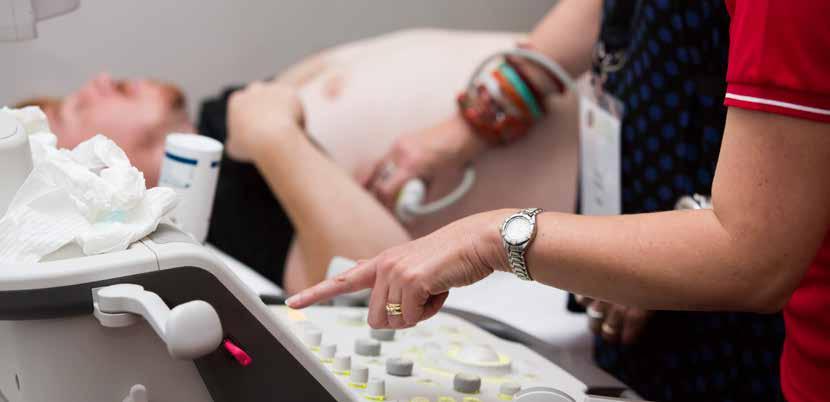
Key performance measures
Each year Key Performance Indicators are set cross the business based on the strategic intent and the shortterm goals of the organisation. Individual performance plans are agreed to by each staff member with clear performance and behavioural targets outlined in July, a half yearly review performed in December and a final appraisal performed at the end of the financial year.
The surplus of the company for the reporting period after provision for income tax and before other comprehensive income was $328,583 (2019 surplus was $905,685).
Significant changes in the state of affairs
In the opinion of the directors there were no significant changes in the state of affairs of the company that occurred during the financial year under review not otherwise disclosed in this report or the financial statements.
Matters subsequent to the end of the financial period
There are no matters or circumstances that have arisen since the end of the financial period that have significantly affected or may significantly affect the operations of the company, the results of those operations or the state of affairs of the company, in future years.
Likely developments
Likely developments in the operations of the company and the expected results of those operations in future financial years have not been included in this report as the inclusion of such information is likely to result in unreasonable prejudice to the company.
The company is not subject to any significant environmental regulation.
At the end of the reporting period Australasian Sonographers Association Ltd had 6,818 members.
Australasian Sonographers Association Ltd is a company limited by guarantee. In the event of, and for the purpose of winding up of the company, the amount capable of being called up from each member and any person or association who ceased to be a member in the year prior to the winding up, is limited to $20, subject to the provisions of the company’s constitution.
At 30 June 2020 the collective liability of members was $136,360 (30 June 2019: $127,120).
Auditor’s independence declaration
A copy of the auditor’s independence declaration as required under section 60-40 of the Australian Charities and Not-for-profits Commission Act 2012 is set out on page 42.
This report is made in accordance with a resolution of directors, pursuant to section 298(2)(a) of the Corporations Act 2001.
On behalf of the directors

Ian Schroen Director

AUDITOR’S INDEPENDENCE DECLARATION TO THE DIRECTORS OF AUSTRALASIAN SONOGRAPHERS ASSOCIATION LTD
In accordance with the requirements of section 60-40 of the Australian Charities and Not-for-profits Commission Act 2012, I declare that, to the best of my knowledge and belief, during the year ended 30 June 2020 there have been:
(i) no contraventions of the auditor independence requirements as set out in the Australian Charities and Not-for-profits Commission Act 2012 in relation to the audit; and
(ii) no contraventions of any applicable code of professional conduct in relation to the audit.


Melbourne 20 August 2020

The financial statements cover Australasian Sonographers Association Ltd as an individual entity. The financial statements are presented in Australian dollars, which is Australasian Sonographers Association Ltd’s functional and presentation currency.
Australasian Sonographers Association Ltd is a not-for-profit unlisted public company limited by guarantee.
The financial statements were authorised for issue, in accordance with a resolution of directors, upon the date of signing this report. The directors have the power to amend and reissue the financial statements.
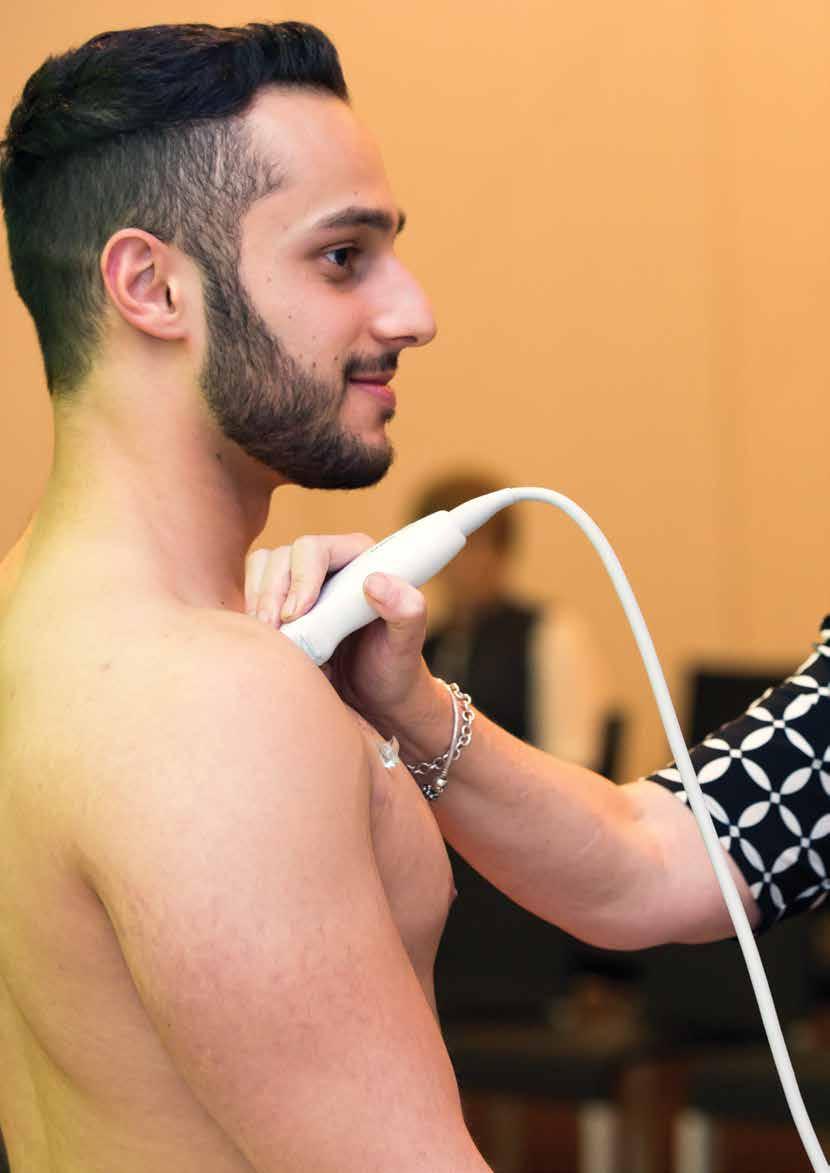
STATEMENT OF PROFIT OR LOSS AND OTHER COMPREHENSIVE INCOME FOR THE YEAR ENDED 30 JUNE 2020
Note 1. Significant accounting policies
Note 1. Significant accounting policies
The principal accounting policies adopted in the preparation of the financial statements are set out below. These policies have been consistently applied to all the years presented, unless otherwise stated.
New, revised or amending Accounting Standards and Interpretations adopted
The company has adopted all of the new or amended Accounting Standards and Interpretations issued by the Australian Accounting Standards Board (‘AASB’) that are mandatory for the current reporting period.
Any new or amended Accounting Standards or Interpretations that are not yet mandatory have not been early adopted.
The adoption of these Accounting Standards and Interpretations did not have any significant impact on the financial performance or position of the company.
The following Accounting Standards and Interpretations are most relevant to the company:
AASB 15 Revenue from Contracts with Customers
The company has adopted AASB 15 from 1 July 2019. The standard provides a single comprehensive model for revenue recognition. The core principle of the standard is that an entity shall recognise revenue to depict the transfer of promised goods or services to customers at an amount that reflects the consideration to which the entity expects to be entitled in exchange for those goods or services. The standard introduced a new contractbased revenue recognition model with a measurement approach that is based on an allocation of the transaction price. This is described further in the accounting policies below. Credit risk is presented separately as an expense rather than adjusted against revenue. Contracts with customers are presented in an entity’s statement of financial position as a contract liability, a contract asset, or a receivable, depending on the relationship between the entity’s performance and the customer’s payment. Customer acquisition costs and costs to fulfil a contract can, subject to certain criteria, be capitalised as an asset and amortised over the contract period.
AASB 16 Leases
The company has adopted AASB 16 from 1 July 2019. The standard replaces AASB 117 ‘Leases’ and for lessees eliminates the classifications of operating leases and finance leases. Except for short-term leases and leases of low-value assets, right-of-use assets and corresponding
lease liabilities are recognised in the statement of financial position. Straight-line operating lease expense recognition is replaced with a depreciation charge for the right-ofuse assets (included in operating costs) and an interest expense on the recognised lease liabilities (included in finance costs). In the earlier periods of the lease, the expenses associated with the lease under AASB 16 will be higher when compared to lease expenses under AASB 117. However, EBITDA (Earnings Before Interest, Tax, Depreciation and Amortisation) results improve as the operating expense is now replaced by interest expense and depreciation in profit or loss. For classification within the statement of cash flows, the interest portion is disclosed in operating activities and the principal portion of the lease payments are separately disclosed in financing activities. For lessor accounting, the standard does not substantially change how a lessor accounts for leases.
AASB 1058 Income of Not-for-Profit Entities
The company has adopted AASB 1058 from 1 July 2019. The standard replaces AASB 1004 ‘Contributions’ in respect to income recognition requirements for not-forprofit entities. The timing of income recognition under AASB 1058 is dependent upon whether the transaction gives rise to a liability or other performance obligation at the time of receipt. Income under the standard is recognised where: an asset is received in a transaction, such as by way of grant, bequest or donation; there has either been no consideration transferred, or the consideration paid is significantly less than the asset’s fair value; and where the intention is to principally enable the entity to further its objectives. For transfers of financial assets to the entity which enable it to acquire or construct a recognisable non-financial asset, the entity must recognise a liability amounting to the excess of the fair value of the transfer received over any related amounts recognised. Related amounts recognised may relate to contributions by owners, AASB 15 revenue or contract liability recognised, lease liabilities in accordance with AASB 16, financial instruments in accordance with AASB 9, or provisions in accordance with AASB 137. The liability is brought to account as income over the period in which the entity satisfies its performance obligation. If the transaction does not enable the entity to acquire or construct a recognisable non-financial asset to be controlled by the entity, then any excess of the initial carrying amount of the recognised asset over the related amounts is recognised as income immediately. Where the fair value of volunteer services received can be measured, a private sector not-for-profit entity can elect to recognise the value of those services as an asset where asset recognition criteria are met or otherwise recognise the value as an expense.
Impact of adoption
AASB 15, AASB 16 and AASB 1058 were adopted using the modified retrospective approach and as such comparatives have not been restated.
AASB 16 Leases
Impact on assets, liabilities and equity as at 1 July 2019
On transition to AASB 16, the Company recognised $393,592 of right-of-use assets and $403,956 of lease liabilities, recognising the difference of $10,364 as a
The impact of the new Accounting Standards compared with the previous Accounting Standards on the current reporting period is as follows:
decrease in accumulated surplus. When measuring lease liabilities, the Company discounted lease payments using its incremental borrowing rate of 5%.
The adoption of these new Standards requires the Company to recognise revenue in line with the performance obligations of a contract. Where sufficiently specific performance obligations do not exist, revenue is recognised upon receipt in line with AASB 1058. This has not resulted in any changes to the recognition of revenue for the Company.
The AASB has released a number of other Accounting Standards and Australian Interpretations. The application of these Accounting Standards and Australian Interpretations are not expected to have any significant impact on the Company’s financial statements. Consequently, they have not been specifically identified above.
Basis of preparation
These general purpose financial statements have been prepared in accordance with Australian Accounting
Standards – Reduced Disclosure Requirements and Interpretations issued by the Australian Accounting Standards Board (‘AASB’), the Australian Charities and Not-for-profits Commission Act 2012 and Victorian legislation the Fundraising Act 1998 and associated regulations and the Corporations Act 2001, as appropriate for not-for-profit oriented entities.
Historical cost convention
The financial statements have been prepared under the historical cost convention.
Critical accounting estimates
The preparation of the financial statements requires the use of certain critical accounting estimates. It also requires management to exercise its judgement in the process of applying the company’s accounting policies.
The areas involving a higher degree of judgement or complexity, or areas where assumptions and estimates are significant to the financial statements, are disclosed in Note 2.
Note 1. Significant accounting policies
Revenue recognition
The company recognises revenue as follows:
Revenue from contracts with customers (member subscriptions, sponsorship income, event revenue, advertising income, education registrations)
Revenue is recognised at an amount that reflects the consideration to which the company is expected to be entitled in exchange for transferring goods or services to a customer. For each contract with a customer, the company: identifies the contract with a customer; identifies the performance obligations in the contract; determines the transaction price which takes into account estimates of variable consideration and the time value of money; allocates the transaction price to the separate performance obligations on the basis of the relative stand-alone selling price of each distinct good or service to be delivered; and recognises revenue when or as each performance obligation is satisfied in a manner that depicts the transfer to the customer of the goods or services promised.
Variable consideration within the transaction price, if any, reflects concessions provided to the customer such as discounts, rebates and refunds, any potential bonuses receivable from the customer and any other contingent events. Such estimates are determined using either the ‘expected value’ or ‘most likely amount’ method. The measurement of variable consideration is subject to a constraining principle whereby revenue will only be recognised to the extent that it is highly probable that a significant reversal in the amount of cumulative revenue recognised will not occur. The measurement constraint continues until the uncertainty associated with the variable consideration is subsequently resolved. Amounts received that are subject to the constraining principle are recognised as a refund liability.
Interest
Interest revenue is recognised as interest accrues using the effective interest method, which for floating rate financial assets is the rate inherent in the instrument.
Dividend revenue
Dividend revenue is recognised when the right to receive a dividend has been established.
Other revenue
Other revenue is recognised when it is received or when the right to receive payment is established.
Income tax
As the company is a charitable institution in terms of subsection 50-5 of the Income Tax Assessment Act 1997, as amended, it is exempt from paying income tax.
Current and non-current classification
Assets and liabilities are presented in the statement of financial position based on current and non-current classification.
An asset is classified as current when: it is either expected to be realised or intended to be sold or consumed in the company’s normal operating cycle; it is held primarily for the purpose of trading; it is expected to be realised within 12 months after the reporting period; or the asset is cash or cash equivalent unless restricted from being exchanged or used to settle a liability for at least 12 months after the reporting period. All other assets are classified as non-current.
A liability is classified as current when: it is either expected to be settled in the company’s normal operating cycle; it is held primarily for the purpose of trading; it is due to be settled within 12 months after the reporting period; or there is no unconditional right to defer the settlement of the liability for at least 12 months after the reporting period. All other liabilities are classified as non-current.
Cash and cash equivalents includes cash on hand, deposits held at call with financial institutions, other shortterm, highly liquid investments with original maturities of three months or less that are readily convertible to known amounts of cash and which are subject to an insignificant risk of changes in value.
Other receivables are recognised at amortised cost, less any allowance for expected credit losses.
The company classifies its financial assets between current and non current assets based on the purpose for which the assets were acquired. Management determines the classification of its financial assets at initial recognition.
The company assesses at each balance sheet date whether a financial asset or group of financial assets is impaired. All financial assets except those measured at fair value through profit or loss are subject to annual review for impairment.
At the end of each reporting period the company assesses whether there is objective evidence that a financial asset or group of financial assets is impaired.
Note 1. Significant accounting policies
All financial assets, except those measured at fair value through the Statement of Profit or loss and other comprehensive Income, are subject to annual review for impairment.
In order to determine an appropriate fair value as at 30 June 2020 for its portfolio of financial assets, the company used the market value of investments held.
Financial assets at fair value through profit or loss
Equity instruments (managed investment portfolio) that are held for trading as well as derivative instruments are classified as fair value through profit or loss.
Other financial assets are required to be measured at fair value through profit or loss unless they are measured at amortised cost or fair value through other comprehensive income as explained above.
Property, plant and equipment
Plant and equipment is stated at historical cost less accumulated depreciation and impairment. Historical cost includes expenditure that is directly attributable to the acquisition of the items
Depreciation is calculated on a straight-line basis to write off the net cost of each item of property, plant and equipment (excluding land) over their expected useful lives as follows:
Office equipment
3 – 5 years
Leasehold improvements 5 years
The residual values, useful lives and depreciation methods are reviewed, and adjusted if appropriate, at each reporting date.
An item of property, plant and equipment is derecognised upon disposal or when there is no future economic benefit to the company. Gains and losses between the carrying amount and the disposal proceeds are taken to the statement of profit or loss.
Intangible assets
Membership database and website
The membership database and website are initially recognised at cost. These assets have a finite life and are carried at cost less any accumulated amortisation and impairment losses. The membership database and website are amortised on a straight line basis over 5 years. The asset is assessed annually for impairment.
Right of use assets
A right-of-use asset is recognised at the commencement date of a lease. The right-of-use asset is measured at
cost, which comprises the initial amount of the lease liability, adjusted for, as applicable, any lease payments made at or before the commencement date net of any lease incentives received, any initial direct costs incurred, and, except where included in the cost of inventories, an estimate of costs expected to be incurred for dismantling and removing the underlying asset, and restoring the site or asset.
Right-of-use assets are depreciated on a straight-line basis over the unexpired period of the lease or the estimated useful life of the asset, whichever is the shorter. Where the Company expects to obtain ownership of the leased asset at the end of the lease term, the depreciation is over its estimated useful life. Right-of use assets are subject to impairment or adjusted for any remeasurement of lease liabilities.
Impairment of non-financial assets
Non-financial assets are reviewed for impairment whenever events or changes in circumstances indicate that the carrying amount may not be recoverable. An impairment loss is recognised for the amount by which the asset’s carrying amount exceeds its recoverable amount.
Recoverable amount is the higher of an asset’s fair value less costs of disposal and value-in-use. The value-in-use is the present value of the estimated future cash flows relating to the asset using a pre-tax discount rate specific to the asset or cash-generating unit to which the asset belongs. Assets that do not have independent cash flows are grouped together to form a cash-generating unit.
Trade and other payables
These amounts represent liabilities for goods and services provided to the company prior to the end of the financial year and which are unpaid. Due to their short-term nature they are measured at amortised cost and are not discounted. The amounts are unsecured and are usually paid within 30 days of recognition
Employee benefits
Short-term employee benefits
Liabilities for wages and salaries, including non-monetary benefits, annual leave and long service leave expected to be settled within 12 months of the reporting date are measured at the amounts expected to be paid when the liabilities are settled.
Other long-term employee benefits
The liability for annual leave and long service leave not expected to be settled within 12 months of the reporting date are measured as the present value of expected
Note 1. Significant accounting policies
future payments to be made in respect of services provided by employees up to the reporting date using the projected unit credit method. Consideration is given to expected future wage and salary levels, experience of employee departures and periods of service. Expected future payments are discounted using market yields at the reporting date on national government bonds with terms to maturity and currency that match, as closely as possible, the estimated future cash outflows.
Defined contribution superannuation expense
Contributions to defined contribution superannuation plans are expensed in the period in which they are incurred.
Lease liabilities
A lease liability is recognised at the commencement date of a lease. The lease liability is initially recognised at the present value of the lease payments to be made over the term of the lease, discounted using the interest rate implicit in the lease or, if that rate cannot be readily determined, the Company’s incremental borrowing rate. Lease payments comprise of fixed payments less any lease incentives receivable, variable lease payments that depend on an index or a rate, amounts expected to be paid under residual value guarantees, exercise price of a purchase option when the exercise of the option is reasonably certain to occur, and any anticipated termination penalties. The variable lease payments that do not depend on an index or a rate are expensed in the period in which they are incurred.
Lease liabilities are measured at amortised cost using the effective interest method. The carrying amounts are remeasured if there is a change in the following: future lease payments arising from a change in an index or a rate used; residual guarantee; lease term; certainty of a purchase option and termination penalties. When a lease liability is remeasured, an adjustment is made to the corresponding right-of use asset, or to profit or loss if the carrying amount of the right-of-use asset is fully written down.
When an asset or liability, financial or non-financial, is measured at fair value for recognition or disclosure purposes, the fair value is based on the price that would be received to sell an asset or paid to transfer a liability in an orderly transaction between market participants at the measurement date; and assumes that the transaction will take place either: in the principal market; or in the absence of a principal market, in the most advantageous market.
Fair value is measured using the assumptions that market participants would use when pricing the asset or liability,
assuming they act in their economic best interests. For non-financial assets, the fair value measurement is based on its highest and best use. Valuation techniques that are appropriate in the circumstances and for which sufficient data are available to measure fair value, are used, maximising the use of relevant observable inputs and minimising the use of unobservable inputs.
Revenues, expenses and assets are recognised net of the amount of associated GST, unless the GST incurred is not recoverable from the tax authority. In this case it is recognised as part of the cost of the acquisition of the asset or as part of the expense.
Receivables and payables are stated inclusive of the amount of GST receivable or payable. The net amount of GST recoverable from, or payable to, the tax authority is included in other receivables or other payables in the statement of financial position.
Cash flows are presented on a gross basis. The GST components of cash flows arising from investing or financing activities which are recoverable from, or payable to the tax authority, are presented as operating cash flows.
Commitments and contingencies are disclosed net of the amount of GST recoverable from, or payable to, the tax authority.
Note 2. Critical accounting judgements, estimates and assumptions – Note 3. Impact of COVID-19 Pandemic on operations and 2019–20 Financial Report
Note 2. Critical accounting judgements, estimates and assumptions
The preparation of the financial statements requires management to make judgements, estimates and assumptions that affect the reported amounts in the financial statements. Management continually evaluates its judgements and estimates in relation to assets, liabilities, contingent liabilities, revenue and expenses. Management bases its judgements, estimates and assumptions on historical experience and on other various factors, including expectations of future events, management believes to be reasonable under the circumstances. The resulting accounting judgements and estimates will seldom equal the related actual results. The judgements, estimates and assumptions that have a significant risk of causing a material adjustment to the carrying amounts of assets and liabilities (refer to the respective notes) within the next financial year are discussed below.
Coronavirus (COVID-19) pandemic
Judgement has been exercised in considering the impacts that the Coronavirus (COVID-19) pandemic has had, or may have, on the company based on known information. This consideration extends to the nature of the services offered, members, supply chain, staffing and geographic regions in which the company operates. The impacts of COVID-19 on the company and operations and the financial report are further set out in Note 3.
Estimation of useful lives of assets
The company determines the estimated useful lives and related depreciation and amortisation charges for its property, plant and equipment and finite life intangible assets. The useful lives could change significantly as a result of technical innovations or some other event. The depreciation and amortisation charge will increase where the useful lives are less than previously estimated lives, or technically obsolete or non-strategic assets that have been abandoned or sold will be written off or written down.
Impairment of non-financial assets other than goodwill and other indefinite life intangible assets
The company assesses impairment of non-financial assets other than goodwill and other indefinite life intangible assets at each reporting date by evaluating conditions specific to the company and to the particular asset that may lead to impairment. If an impairment trigger exists, the recoverable amount of the asset is determined. This involves fair value less costs of disposal or value-in-use calculations, which incorporate a number of key estimates and assumptions.
Employee benefits provision
As discussed in Note 1, the liability for employee benefits expected to be settled more than 12 months from the reporting date are recognised and measured at the present value of the estimated future cash flows to be made in respect of all employees at the reporting date. In determining the present value of the liability, estimates of attrition rates and pay increases through promotion and inflation have been taken into account.
On 30 January 2020, COVID-19 was declared as a global pandemic by world health organisation. Since then, various measures are taken by all three levels of Government in Australia to reduce the spread of COVID-19. The impact of the Coronavirus (COVID-19) pandemic is ongoing. The pandemic has had the following impacts on the company operations:
Membership Revenue
Membership subscriptions are continuing to be received. In the event of a further economic deterioration in the Australian economy, the strong financial position of the Company will assist in dealing with any associated decline in membership revenue.
Event Revenue
The Company’s event revenues have been significantly impacted by the Coronavirus (COVID-19) pandemic with the cancellation of the annual conference this year. The decrease in event revenue has been offset by reduced expenditure that was not incurred as a result of cancellation of the event.
Cash Boost Stimulus
The company has qualified to receive the government cash boost stimulus ($50,000) which is included in the revenue of the company.
Investments
The COVID-19 outbreak has had a significant impact on global financial markets and the Company’s investment portfolio has decreased in value as at 30 June 2020 by $60,679. In addition, the company has transferred monies from term deposits to cash on hand as part of its investment strategy in this time.
Note 4. Revenue – Note 7. Financial Assets
Note 5. Cash and Cash Equivalents
Note 6. Trade and Other Receivables
Note 7. Financial Assets
Note 14. Related parties and related party transactions – Note 16. Commitments for
Note 14.
Note 15. Contingent liabilities
Note 16. Commitments for expenditure
Note 17. Events subsequent to the end of the financial year
The future impacts of the COVID-19 pandemic on the company is uncertain. Since the reporting date world financial markets have shown volatility and this has affected the carrying value of the company’s investment portfolio. The company considers that it has a conservative investment strategy to manage exposure to this volatility.
No other matter or circumstances has arisen since 30 June 2020 that has significantly affected, or may significantly affect the company’s operations, the results of those operations, or the company’s state of affairs in future financial years.
Note 18. Reconciliation of result for the year to net cash (outflow)/inflow from operating activities
Movements
In the directors’ opinion:
• the attached financial statements and notes comply with the Corporations Act 2001, the Australian Accounting Standards – Reduced Disclosure Requirements, the Australian Charities and Not-for-profits Commission Act 2012, the Corporations Regulations 2001 and other mandatory professional reporting requirements
• the attached financial statements and notes give a true and fair view of the company’s financial position as at 30 June 2020 and of its performance for the financial year ended on that date; and
• there are reasonable grounds to believe that the company will be able to pay its debts as and when they become due and payable.
Signed in accordance with a resolution of directors made pursuant to section 295(5)(a) of the Corporations Act 2001.
On behalf of the directors

Ian Schroen

Silvano Palladino Director Director
20 August 2020
20 August 2020 Melbourne Perth
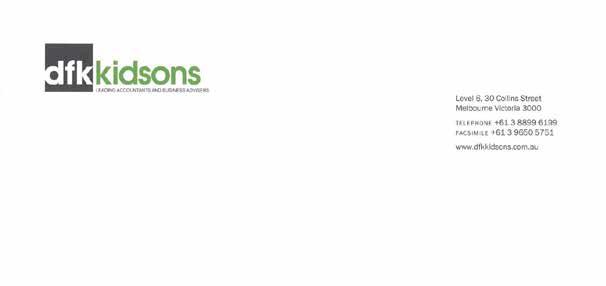
INDEPENDENT AUDITOR'S REPORT
TO THE MEMBERS OF AUSTRALASIAN SONOGRAPHERS ASSOCIATION LTD
Opinion
We have audited the financial report of Australasian Sonographers A ssociation Ltd which comprises the statement of financial position as at 30 June 2020, the statement of comprehensive in come, statement of changes in equity and statement of cash flows for the year then ended, and notes to the financial statem ents, including a summary of significant accounting policies, and the directors' declaration.

In our opinion, the accompanying financial report of Australasi an Sonographers Association Ltd, is in accordance with the Australian Charities and Not-for-profits Commission Act 2012 , including:
(a) giving a true and fair view of the company's financial position as at 30 June 2020 and of its financial performance for the year then ended; and
(b) complying with Australian Accounting Standards – Reduced Disclosure Requirements and Division 60 of the Australian Charities and Not-for-pro fits Commission Regulation 2013.
Basis for Opinion
We conducted our audit in accordance with Australian Auditing Standards. Our responsibilities under those standards are further described in the Auditor's Responsibilities for the Audit of the Financial Report section of our report. We are independent of the Company in accordance with the auditor independence requirements of the Australian Charities and Not-for-profits Commission Act 2012 and the ethical requirements of the Accounting Professional and Ethical Standards Board's APES 110 Code of Ethics for Professional Accountants (the Code) that are relevant to our audit of the financial report in Australia. We have also fulfilled our other ethical responsibilities in accordance with the Code.
We believe that the audit evidence we have obtained is sufficient and appropriate to provide a basis for our opinion.
Responsibilities of the Directors for the Financial Report
The directors of the Company are responsible for the preparation of the financial report that gives a true and fair view in accordance with Australian Accounting Standards – Reduced Disclosure Requirements and the Australian Charities and Notfor-profits Commission Act 2012 and for such internal control as the director s determine is necessary to enable the preparation of the financial report that gives a true and fair view and is fr ee from material misstatement, whether due to fraud or error.
In preparing the financial report, the directors are responsible for assessing the Company's ability to continue as a going concern, disclosing, as applicable, matters related to going concern and using the going concern basis of accounting unless the directors either intend to liquidate the Company or to c ease operations, or have no realistic alternative but to do so.
Those charged with governance are responsible for overseeing the Company's financial reporting process
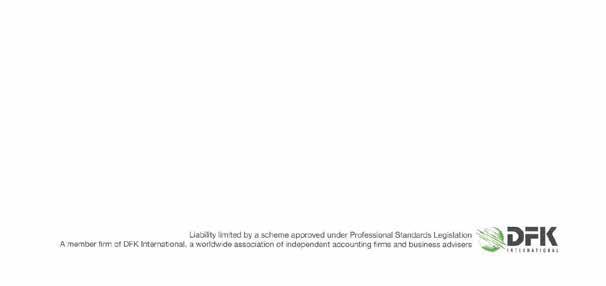

Auditor's Responsibilities for the Audit of the Financial Report
Our objectives are to obtain reasonable assurance about whether the financial report as a whole is free from material misstatement, whether due to fraud or error, and to issue an auditor's report that includes our opinion. Reasonable assurance is a high level of assurance, but is not a guarantee that an audit conducted in accordance with the Australian Auditing Standards will always detect a material misstatement when it exists. Misstatements can arise from fraud or error and are considered material if, individually or in the aggregate, they could reasonably be expected to influence the economic decisions of users taken on the basis of this financial report.
As part of an audit in accordance with the Australian Auditing Standards – Reduced Disclosure Requirements, we exercise professional judgement and maintain professional scepticism throughout the audit. We also:

• Identify and assess the risks of material misstatement of the financial report, whether due to fraud or error, design and perform audit procedures responsive to those risks, and obtain audit evidence that is sufficient and appropriate to provide a basis for our opinion. The risk of not detecting a material misstatement resulting from fraud is higher than for one resulting from error, as fraud may involve collusion, forgery, intentional omissions, misrepresentations, or the override of internal control.
• Obtain an understanding of internal control relevant to the audit in order to design audit procedures that are appropriate in the circumstances, but not for the purpose of expressing an opinion on the effectiveness of the Company's internal control.
• Evaluate the appropriateness of accounting policies used and the reasonableness of accounting estimates and related disclosures made by the directors.
• Conclude on the appropriateness of the directors' use of the going concern basis of accounting and, based on the audit evidence obtained, whether a material uncertainty exists related to events or conditions that may cast significant doubt on the Company's ability to continue as a going concern. If we conclude that a material uncertainty exists, we are required to draw attention in our auditor's report to the related disclosures in the financial report or, if such disclosures are inadequate, to modify our opinion. Our conclusions are based on the audit evidence obtained up to the date of our auditor's report. However, future events or conditions may cause the Company to cease to continue as a going concern.
• Evaluate the overall presentation, structure and content of the financial report, including the disclosures, and whether the financial report represents the underlying transactions and events in a manner that achieves fair presentation.
We communicate with the directors regarding, among other matters, the planned scope and timing of the audit and significant audit findings, including any significant deficiencies in internal control that we identify during our audit.
We also provide the directors with a statement that we have complied with relevant ethical requirements regarding independence, and to communicate with them all relationships and other matters that may reasonably be thought to bear on our independence, and where applicable, related safeguards.

DFK Kidsons Partnership

Robert Wernli
Partner

Melbourne
20 August 2020
In 2020 the ASA took the step to become one of only four major partners of Radiology Across Borders (RAB). After the enthusiasm for sonographers to join RAB’s VITAL Project trip to Vietnam in 2019, the ASA decided to support all of RAB’s project work, including training for the ultrasound VITAL projects.
The ASA is passionate about outreach work and are committed to making a tangible difference in developing countries globally through education. Radiology Across Borders believes that if you have the ability to save a life, you have the responsibility to do so, and trains local healthcare staff in developing nations in radiology to detect and treat illnesses which helps save lives, thus making for a natural fit for the two organisations.
